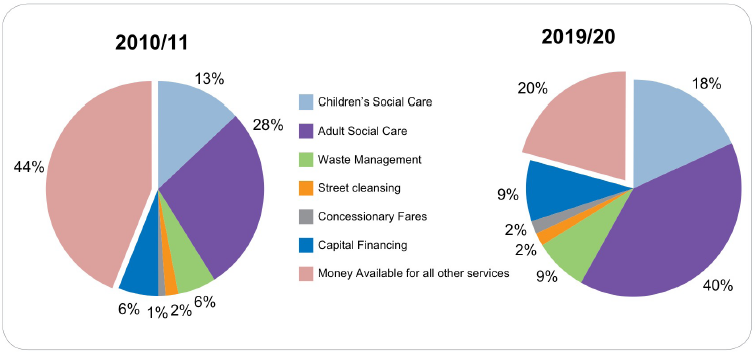Rigid statutory demands, budget cuts, and lack of political choice are strangling local government innovation
Local Authorities have been having a difficult ride since the formation of the Conservative/Liberal Democrat coalition in May 2010. As it potentially draws to a close, Cllr Tim Cheetham argues that the rigidity of statutoury guidance from the Department for Communities and Local Government, cuts to Local Authority budgets, and a stifling lack of political choice for voters are each threatening to heighten already dangerous levels of political disengagement and strangle local government innovation.

Credit: Birmingham News Room, CC BY 2.0
‘Necessity is the mother of invention’ so they say. In local government services the ‘necessity’ of working within austerity budgets has been at best a major consideration and more typically the driving force behind everything for five or six years. The extent to which central government control local government finances in the U.K. has been the subject of much literature. Since the Layfield Committee report expressed concern in 1976 about the proportion of directly controlled income local authorities had, that proportion has progressively decreased. Factor in capping, the requirement to set balanced revenue budgets every year and other legal measures and the U.K. now has some of the highest levels of central government control over local government revenues of any European country.
The control does not end there though, with the increasingly statutory nature of service provision adding to the constraint on local councils. Despite the Coalition rhetoric of devolved power there is little evidence from local leaders that this is as extensive as central government would suggest. The overall impression from practitioners has much in common with the previous Labour government attempts. The response to the final Select Committee Report in 2009 said, “The Government’s record appears to us to be mixed. There remains a sizeable gap between the newly empowered local government that the Government believes it has established in principle, and the actual impact as witnessed at the local level.” The experience of local leaders in 2015 is much the same. It remains the case that not only are councils essentially told how much money they have to spend but also how they must spend it, by central government.
This sector has, on the face of if, seen an explosion of transformation, redesign and innovation in the last five years. The mantra of ‘more for less’ has required new ways to deliver local public services. But how innovative is it really? Though approaches to service delivery may superficially vary, everything in central legislation and statutory requirement shapes the front end of services and expected outcomes. This has combined with a ministerial approach described by many as ‘micromanagement’, typified by interference in issues such as the frequency of bin collections, car parking charges and even the enforcement of local fines .
The central government paranoia about avoiding ‘postcode lottery’ services has meant a heavy hand in dictating performance by successive governments. So regardless of whether councils claim to be ‘easy councils’, ‘cooperative councils’ or ‘commissioning councils’ they are under pressure to make the resident experience feel more like the Starbucks or McDonalds council. We see this played out in the way the same service areas have been cut in councils across the country. Regardless of size, region, locality or political leadership of councils; libraries, youth services, children centres, community buildings and others have been on the cuts list almost everywhere.
So, why has this happened? The graph below shows the LGA forecast for local authority budget changes over ten years. The reduction in overall income coupled with increasing demands on key areas such as social care push up the proportion spent on statutory services. Note the scale of reduction in the money available for all other services.
The Local Government Association have issued their direst warnings that within this ten year period, the hardest pressed councils will only be able to provide the essential statutory services such as children’s safeguarding and adult social care. The discretionary element of their spending will be gone completely. This was the headline commentary of the now legendary Barnet ‘graph of doom’ research. As Barnet council’s chief executive, Nick Walkley, said in The Guardian in 2012, “In five to seven years we get to the point where it starts to restrict our ability to do anything very much else…adult social care and children’s services would need to take up the totality of our existing budget.”
The key to understanding the additional impacts of local government austerity is the massive reduction in the portion of local authority funding available for all other services. This is, in political and local terms, where the magic happens. It is with this resource that councils are truly able to shape themselves (and the services they provide or commission) based on their locality and not central government prescription. And where does this leave politics? Have such apparently trivial concerns as political ideology and manifesto choices become subservient to the demands of statutory requirements, central government guidance and budgetary constraint?
Politicians are struggling to identify themselves, to offer alternative narratives and give voters genuine choice about the shape and direction of their council at the ballot box. The essential point is that a manifesto/strategic direction is the basis on which leaders (and most particularly ‘potential’ leaders) define themselves to their electorate. As the delivery of a statement of political intent such as a manifesto or strategic plan will ultimately require the use of council resources in one form or another, constraint falls heavily on this sphere of politics. Even in the politics of local government options are reduced and Homogeneity increases. The lack of political differentiation increases the worries over voter disengagement. This in turn is an issue of particular concern to local leaders, where “…the problem (of voter apathy) seems to be most acute in local government.”
Asking the question: Is innovation in local government still possible in the face of these overwhelming and coordinated pressures? Or will the rigidity of statutory demands, radically reduced budgets and lack of political choices drive all local authorities into the same methods and patterns. Are solutions which are non-uniform, ideologically creative, genuinely locality driven, still possible in this economic environment?
Can each individual “local” government retain an identity in defiance of this hegemony of homogony?
—
Note: this post represents the views of the author, and not those of Democratic Audit or the LSE. Please read our comments policy before posting.
—
 Tim Cheetham is a member of the Local Government Research Group at De Montfort University and a cabinet member on Barnsley MBC. With over 10 years as an elected member he regularly represents local government at a national level specialising in innovation, leadership, data and the use of social media. His field of doctoral research is currently local government leadership and austerity.
Tim Cheetham is a member of the Local Government Research Group at De Montfort University and a cabinet member on Barnsley MBC. With over 10 years as an elected member he regularly represents local government at a national level specialising in innovation, leadership, data and the use of social media. His field of doctoral research is currently local government leadership and austerity.






 Democratic Audit's core funding is provided by the Joseph Rowntree Charitable Trust. Additional funding is provided by the London School of Economics.
Democratic Audit's core funding is provided by the Joseph Rowntree Charitable Trust. Additional funding is provided by the London School of Economics.
Can ‘individual’ #LocalGov’s retain an identity in defiance of an hegemony of homogony? Great piece by @cllrtim https://t.co/5ZuW3bKlkm
Interesting post by Tim Cheetham on @democraticaudit local government’s innovation crisis https://t.co/rhe7hAVDFh
Rigid statutory demands, budget cuts, and lack of political choice are strangling local government innovation https://t.co/YvlQpBAoP6